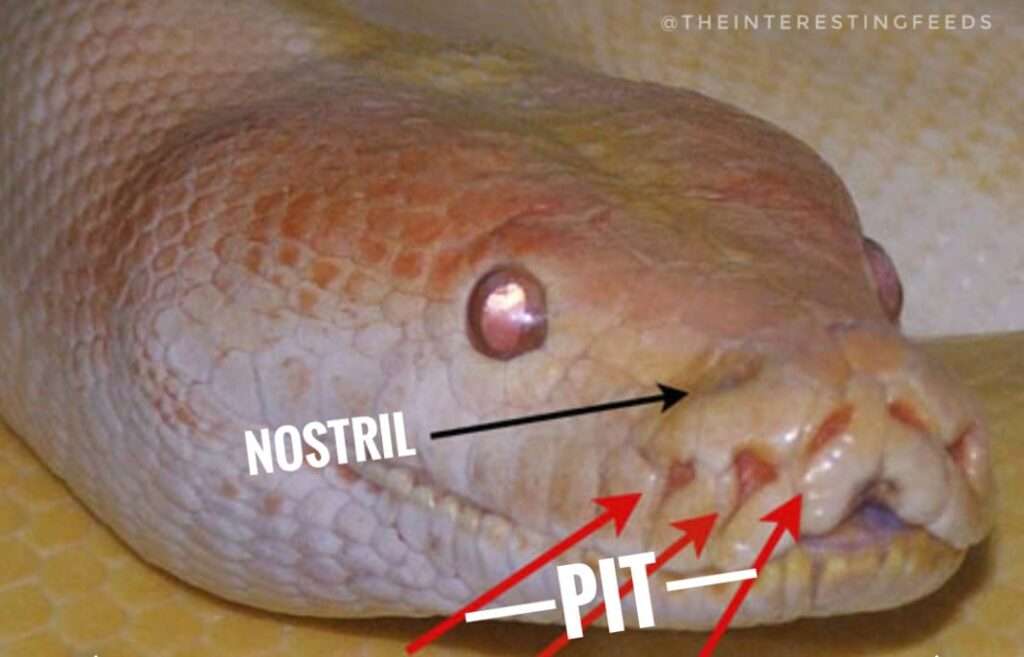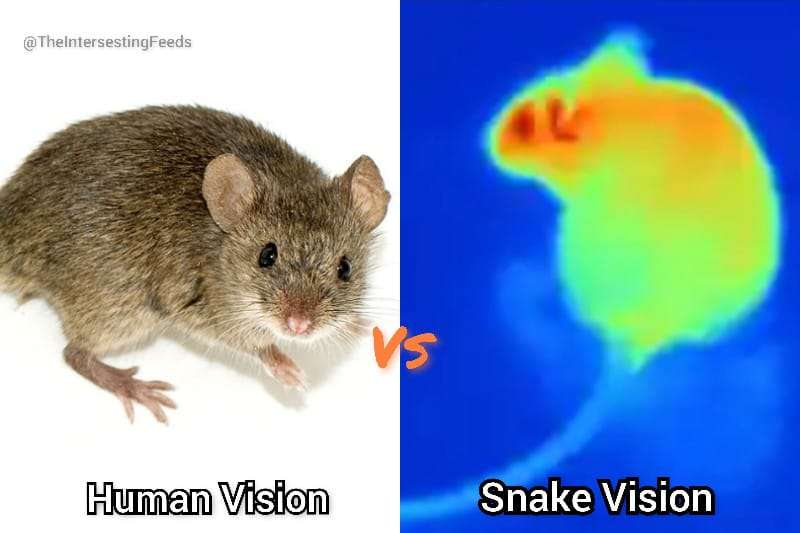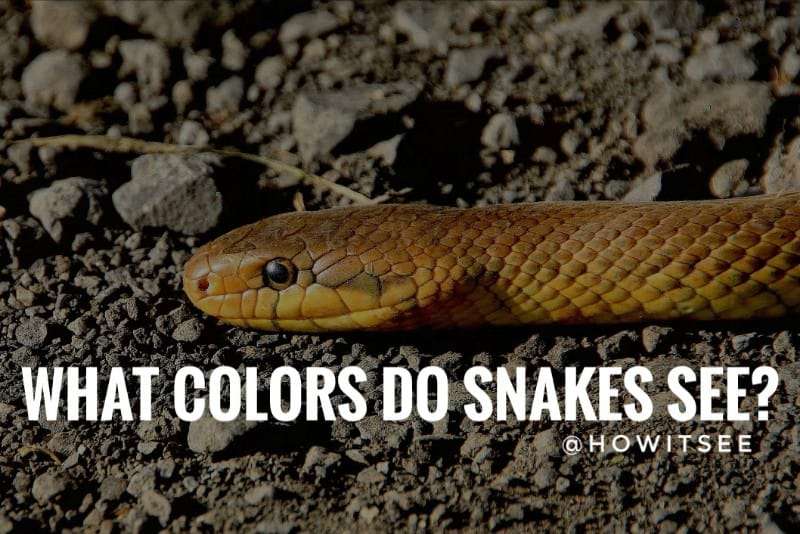Snakes are one of the longevous reptiles that have been on the Earth since the Cretaceous Period. From this period, they have begun to evolve according to the environment. During evolution, these reptiles have attained many features. Presently, a question materialized on the internet, “Can Snakes see color,” or “What color do Snakes see?”
The answer to this question is: Snakes can see colors but can’t distinguish them as well as humans can. Some families of snakes can see visible spectrum or even the ultraviolet range, and some are dependent on infrared radiation. According to the study, snakes are dichromats, resulting in the low differentiation of the colors.
Still, it is difficult to figure out how Snakes comprehend the light.
Also, it is confirmed that they have infamously poor eyesight, but snakes can “see” a more comprehensive range of electromagnetic spectrum compared to humans to gain the upper hand.
Later in this post, we will discuss more on snakes’ eyes, how they perceive light, and how their vision is different from ours in detail. So, without any delay, let’s begin.
What colors do Snakes see?
Many snakes have a relatively low-resolution color vision as compared to humans. They can see various shades and colors, but it totally depends on species to species. Their eyes comprise rods and cones, but due to being dichromatic, the opsins in these cones react to only two colors, i.e., blue and green, whereas human eyes are trichromatic and react to three colors, i.e., red, blue, and green.

But recent studies show that some species of snakes are primarily tetrachromatic with evolving their UV cone and others losing their red-sensitive cone.
In addition, to gain superiority, they evolve heat pit on their face. Snakes like pythons and boas contain a membrane to detect infrared radiation as low as 10 μm of wavelength from warm bodies, according to ABC News. Also, desert snakes, like rattlesnakes or vipers, can see infrared radiation nearly 90 μm which helps them to hunt at night.
These snakes can see infrared radiation within a radius of one meter, according to “the Nature.”
However, different snakes show different behaviors.

In contrast to the first two paragraphs, some colubrid snakes, like arboreal, have excellent vision. They hunt primarily by using sight and smell because they don’t have heat pits like Boas. Therefore, they need good eyes to hunt. Still, it is not proven what color shades they can distinguish.
In conclusion, what colors Snakes see totally depends on their specifies. They can see different shades of colors. Night snakes have the vision to comprehend more on UV light, which allows them to see better in low light conditions. Also, adding one more point that some snakes are blind; hence they rely on other senses like smell, heat, and hearing.
Are Snakes color blind?
No, snakes are not completely color blind. They can see color and can also perceive some wavelengths invisible to us, like ultraviolet. Their vision is dependent on their species. Each one is different. Example Boomslang or Mamba are known for sharp vision.
Snakes cannot discriminate the red wavelength as they lack the associate cone, but still, their rods are sensitive to it. Also, color shades are the combination of different cones stimuli of various intensities, and as mentioned above, they are dichromatic. It means they can see the diverse blend of colors.
On the other hand, humans are trichromatic, meaning we can perceive all short, medium, and large wavelength colors. But there are some snake species that perceive even the large wavelength colors not the same as humans but differently.
Also, snakes do not require color vision to track their prey or navigate. They have evolved other abilities to sense their surroundings even in the complete darkness or on a bright sunny day.
As we mentioned above, snakes can perceive even the wider range of the spectrum that is even invisible to humans, like ultraviolet. In addition, some species of snakes like vipers are able to sense even the infrared.
They have heat pits on their face to sense the infrared radiations from any hot-blooded animals. Depending on their sizes, they categorize whether the hot-blooded animal is prey or predator.
Like in this way, every species of snake has developed a unique way of sensing the environment. And it isn’t easy to research every species.
Must Read: 30+ Black and Red Snakes (with Pictures)
Can Snakes see Red light?
Yes, snakes can see red light. However, that doesn’t mean it looks the same as it does for humans. Also, many snake owners share their knowledge that the red light ruins their day/night cycle, which causes them stress.
However, the extent to seeing the red light varies depending on their types. Some species of snakes can partially see and don’t have any problem with the red light.
Red light has the longest wavelength; it means day snakes that block UV light to help them see clearly in bright light conditions can see red light but not as much as other bright colors.
How do Snakes see the world?
The answer to this question is totally relying on the species. Snakes that hunt during the day have better vision and are capable of perceiving the visible spectrum. In comparison, underground/night snakes can sense UV lights or infrared radiations (through their pits), which helps them to hunt their prey.

Credits | Julius Lab at UCSF
These reptiles have evolved themselves depending on their lifestyle and environment. Snakes can be diurnal and nocturnal according to their habitat.
In contrast, humans are diurnal and have the best color vision in exchange for night vision. It’s true that snakes cannot discriminate colors like us, but the studies showed that they perceive a wider spectrum than us, which makes them a dangerous predator.
The eyesight of every snake species is different, and they all develop unique ways to find their prey or navigate. For example, water snakes have eyesight that assists them in navigating in the murky water.
On the other hand, nocturnal snakes have pits that allow them to sense infrared radiations. These unique ways of perceiving the environment make them a better species than most animals in terms of vision.
How do Snakes see humans?
Snakes see humans similarly as they see other warm-blooded creatures. After all, it depends on different species of snakes. Snakes with pits can see a human through infrared radiation. Also, a myth was going on in the past that snakes could recognize humans.
But that’s not true. First, snakes don’t have good vision or senses to differentiate two people. However, even if it had required sense, it is still incapable of identifying because of the insufficiency of pattern recognition in the brain.

However, some snakes like Ball Pythons and Corn Snakes are friendly and easy to handle. Some owners believe that they may recognize them. However, it’s not proven.
In conclusion, there is no difference between humans and other warm-blooded animals in the eyes of snakes. They perceive everyone the same according to their species.
How do Corn Snakes see?
Corn snakes may have poor eyesight and are dichromatic. It means their cones react only on two colors, i.e., blue and green. They have blurred vision which allows them to perceive the shape and size of the objects.
Corn Snakes are a species of rat snakes, and they have a lack of heat-sensing pits. Like other rat snakes, they are more active at night. Therefore, there is a possibility that Corn snakes can sense ultraviolent lights or rely on different senses to hunt their prey. Also, they need warm temperatures and sunlight to grow.
Snake vision vs Human vision
| Snake Vision | Human Vision |
| Dichromatic in day light | Trichromatic in day light |
| Wider electromagnetic spectrum (including UV lights & Infrared radiations) | Can see only Visible spectrum |
| Can distinguish less color shades | Distinguish millions of color shades |
Here we conclude our article on “What colors do Snakes see,” along with other queries. We hope you like it. This topic is too generalized. There are far too many species found worldwide with a different set of visual complexity. We will be back with another post. Till then, stay tuned with us.
Must Read: Discover 10+ Snakes that are Red, Black, and White
Frequently Asked Questions-
Q1. Can snakes see infrared light?
Ans. Yes, some snakes have a heat pit on their face to detect infrared radiation.
Q2. Can snakes see you if you don’t move?
Ans. It depends on Snake’s species. If it has a heat pit, then it can detect your infrared radiation.
Symbols-
μm – micrometer
THz – Terahertz
References-
Oxford Academic
Gracheva, E. O. et al. Nature advance online publication doi:10.1038/nature08943 (2010).
Bullock, T. H. & Diecke, F. P. J. Physiol. 134, 47-87 (1956)
Also Read:

Meet Monty, the visionary founder of How It See, being an engineering student, he’s fueled by an insatiable curiosity about the world around him. He is captivated by an eclectic correlation between animal groups, science, and nature, and this fascination drives his quest for understanding.
After completing his degree, he’s set on a mission to delve deep into the realm of nature, accumulating knowledge to share with you through his writing. In the meantime, he loves to watch anime and read anime.

